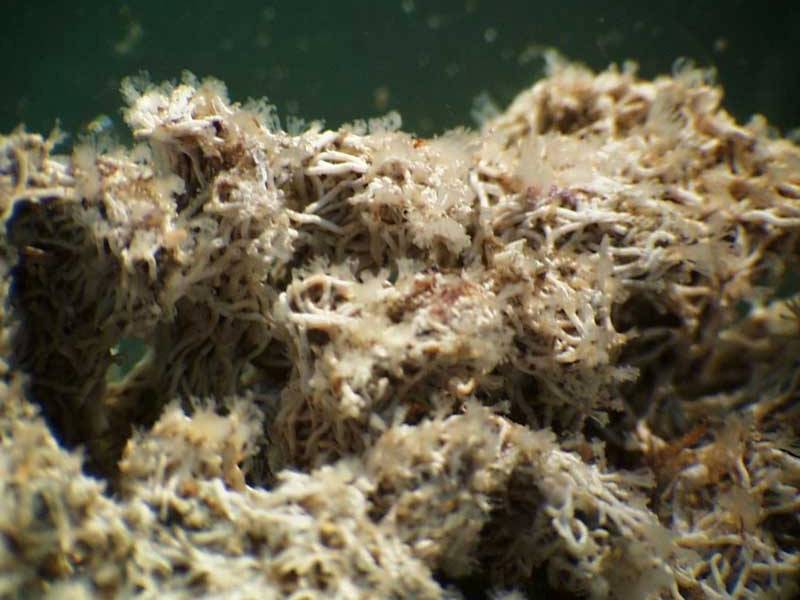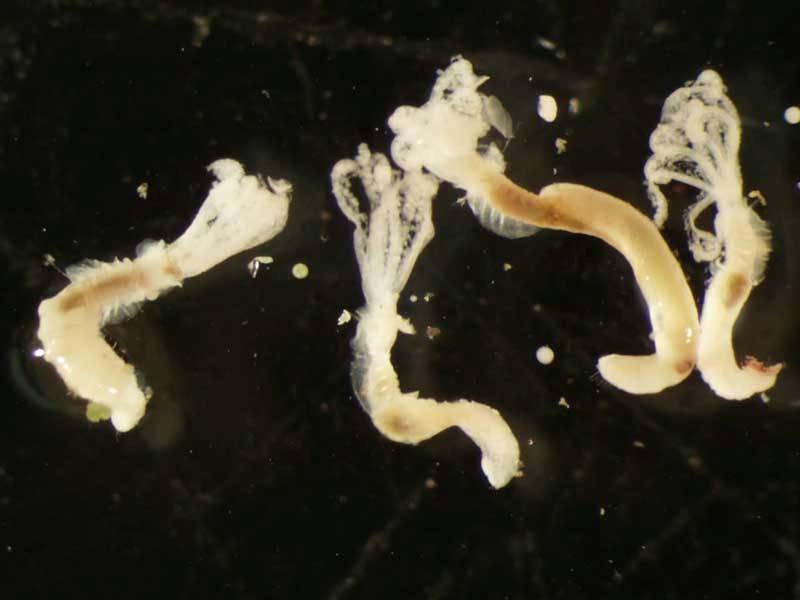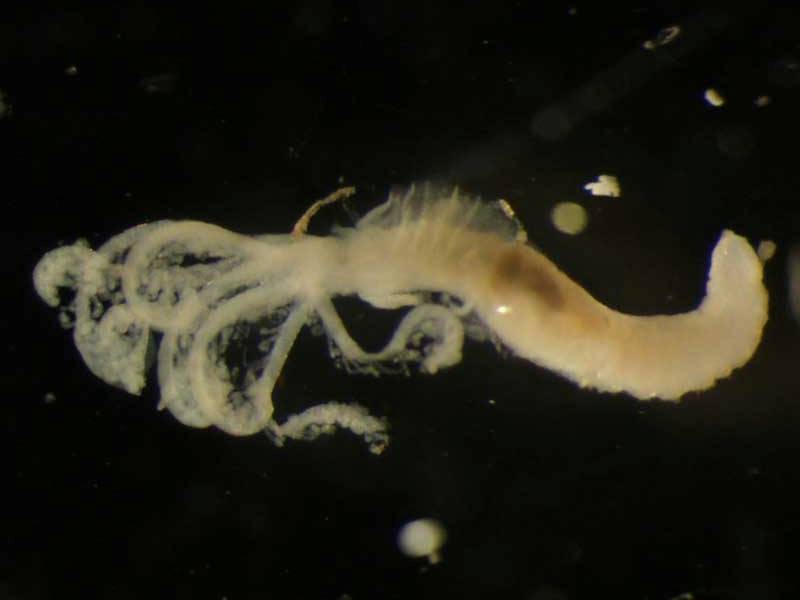Lacy tubeworm (Filograna implexa)
Distribution data supplied by the Ocean Biodiversity Information System (OBIS). To interrogate UK data visit the NBN Atlas.Map Help
| Researched by | Saskiya Richards | Refereed by | Admin |
| Authority | Berkeley, 1835 | ||
| Other common names | - | Synonyms | - |
Summary
Description
Filograna implexa has a translucent, pinkish-grey body up to 0.4-0.5 cm in length. It forms a thin, translucent white tube marked by thin growth rings from which it extends its tentacles and is normally found in colonies of large numbers. The body has up to 35 chaetae-bearing segments divided into a membrane-covered thoracic region of 6-9 segments and abdominal region. An unsegmented region that does not have chaetae separates the thorax and abdomen. The abdominal chaetae are smaller than the thoracic which develop a sickle-shaped towards the posterior end. Each segment also bears a pair of small, toothed, rasp-shaped plates (uncini) attached to the parapoda that are smaller in the abdominal region than in the thoracic region. The head bears two eyes and has two lobes each bearing four colourless, white or pinkish pinnate tentacles. Two of the eight tentacles, one on each side have a distinctive pale yellow, cup-shaped operculum. The base of the tentacles is surrounded by a toothed collar that has finely serrated chaetae and is notched on the ventral surface.
Recorded distribution in Britain and Ireland
Filograna implexa is locally abundant on the coasts of Ireland and the southwest and west of Britain. It has been recorded less frequently on the northeast coast of Britain.Global distribution
Filograna implexa is widespread in northwest Europe, the mediterranean, Japan and the Artic.Habitat
Filograna implexus encrusts bryozoans, corals, Laminaria holdfasts, and a variety of hard substrata including rock crevices, pebbles, stones, shells and sand on the lower shore and in the sublittoral zone.Depth range
-Identifying features
- Network of thin long whitish tubes.
- Greyish-pink translucent body up to 0.4-0.5 cm in length and divided into approximately 35 chaetae-bearing segments.
- Two yellow cup-shaped opercula on tentacles.
- Eight colourless, white or pinkish feather-like tentacles.
- Unsegmented chaetae-less region between thorax and abdomen.
Additional information
Filograna implexus is a filter-feeder. Individuals are gonochoristic and reproduce via a pelagic larval stage throughout July, August and September. Filograna implexus also reproduces by asexual budding. This species can be mistaken for Salmacina dysteri which lacks the distinctive cup-shaped operculum.
Listed by
- none -
Bibliography
Bruce, J.R., Colman, J.S. & Jones, N.S., 1963. Marine fauna of the Isle of Man. Liverpool: Liverpool University Press.
Crothers, J.H. (ed.), 1966. Dale Fort Marine Fauna. London: Field Studies Council.
Fish, J.D. & Fish, S., 1996. A student's guide to the seashore. Cambridge: Cambridge University Press.
Foster-Smith, J. (ed.), 2000. The marine fauna and flora of the Cullercoats District. Marine species records for the North East Coast of England. Sunderland: Penshaw Press, for the Dove Marine Laboratory, University of Newcastle upon Tyne.
Gee, J.M., 1963. On the taxonomy and distribution in south Wales of Filograna, Hydroides and Mercierella (Polychaeta, Serpulidae). Annals and Magazine of Natural History. Series 13, 6, 705-715,
Gibson, R., Hextall, B. & Rogers, A., 2001. Photographic guide to the sea and seashore life of Britain and north-west Europe. Oxford: Oxford University Press.
Hayward, P., Nelson-Smith, T. & Shields, C. 1996. Collins pocket guide. Sea shore of Britain and northern Europe. London: HarperCollins.
Hayward, P.J. & Ryland, J.S. (ed.) 1995b. Handbook of the marine fauna of North-West Europe. Oxford: Oxford University Press.
Howson, C.M. & Picton, B.E., 1997. The species directory of the marine fauna and flora of the British Isles and surrounding seas. Belfast: Ulster Museum. [Ulster Museum publication, no. 276.]
Kupriyanova, E.K., & Jirkov, I.A. 1997. Serpulidae (Annelida, Polychaeta) of the Arctic Ocean. Sarsia, 82(3), 203-236.
Laverack, M.S. & Blackler, D.M., 1974. Fauna & Flora of St. Andrews Bay. Scottish Academic Press (Edinburgh & London).
MBA (Marine Biological Association), 1957. Plymouth Marine Fauna. Plymouth: Marine Biological Association of the United Kingdom.
Nelson-Smith, A., & Gee, J.M. 1966. Serpulid tubeworms (Polychaeta Serpulidae) around Dale, Pembrokeshire. Field Studies, 2, 331-357.
Nishi, E., Yamasu, T., & Kikuchi, T. 1996. Reproductive ecology of the colonial serpulid Filograna implexa (Polychaete). Publications from the Amakusa Marine Biological Laboratory, Kyushu University, 12(2), 63-70.
Picton, B.E., & Costello, M.J., 2001. BioMar biotope viewer: a guide to marine habitats and fauna of Britain and Ireland. http://www.itsligo.ie/biomar/echinode/ECHSEP.HTM, 2001-06-01
Datasets
Bristol Regional Environmental Records Centre, 2017. BRERC species records recorded over 15 years ago. Occurrence dataset: https://doi.org/10.15468/h1ln5p accessed via GBIF.org on 2018-09-25.
Centre for Environmental Data and Recording, 2018. Ulster Museum Marine Surveys of Northern Ireland Coastal Waters. Occurrence dataset https://www.nmni.com/CEDaR/CEDaR-Centre-for-Environmental-Data-and-Recording.aspx accessed via NBNAtlas.org on 2018-09-25.
Fenwick, 2018. Aphotomarine. Occurrence dataset http://www.aphotomarine.com/index.html Accessed via NBNAtlas.org on 2018-10-01
NBN (National Biodiversity Network) Atlas. Available from: https://www.nbnatlas.org.
Norfolk Biodiversity Information Service, 2017. NBIS Records to December 2016. Occurrence dataset: https://doi.org/10.15468/jca5lo accessed via GBIF.org on 2018-10-01.
OBIS (Ocean Biodiversity Information System), 2025. Global map of species distribution using gridded data. Available from: Ocean Biogeographic Information System. www.iobis.org. Accessed: 2025-08-08
South East Wales Biodiversity Records Centre, 2018. SEWBReC Worms (South East Wales). Occurrence dataset: https://doi.org/10.15468/5vh0w8 accessed via GBIF.org on 2018-10-02.
Citation
This review can be cited as:
Last Updated: 17/04/2008





